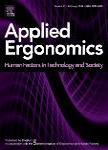版权所有:内蒙古大学图书馆 技术提供:维普资讯• 智图
内蒙古自治区呼和浩特市赛罕区大学西街235号 邮编: 010021

作者机构:Penn State Univ Dept Ind & Mfg Engn University Pk PA 16802 USA Univ Missouri Dept Ind & Mfg Syst Engn Columbia MO 65211 USA Honeywell ACS Labs Minneapolis MN 55422 USA
出 版 物:《APPLIED ERGONOMICS》 (应用人机学)
年 卷 期:2014年第45卷第3期
页 面:693-705页
核心收录:
学科分类:0402[教育学-心理学(可授教育学、理学学位)] 12[管理学] 1201[管理学-管理科学与工程(可授管理学、工学学位)] 08[工学]
基 金:Abnormal Situation Management (ASM) Consortium
主 题:Signal Detection Theory Human-In-The-Loop simulation Continuous monitoring task
摘 要:This paper provides a case study of Signal Detection Theory (SDT) as applied to a continuous monitoring dual-task environment. Specifically, SDT was used to evaluate the independent contributions of sensitivity and bias to different qualitative gauges used in process control. To assess detection performance in monitoring the gauges, we developed a Time Window-based Human-In-The-Loop (TWHITL) simulation bed. Through this test bed, we were able to generate a display similar to those monitored by console operators in oil and gas refinery plants. By using SDT and TWHITL, we evaluated the sensitivity, operator bias, and response time of flow, level, pressure, and temperature gauge-shapes developed by Abnormal Situation Management (R) (ASM (R)) Consortium (***). Our findings suggest that display density influences the effectiveness of participants in detecting abnormal shapes. Furthermore, results suggest that some shapes elicit better detection performance than others. (C) 2013 Elsevier Ltd and The Ergonomics Society. All rights reserved.